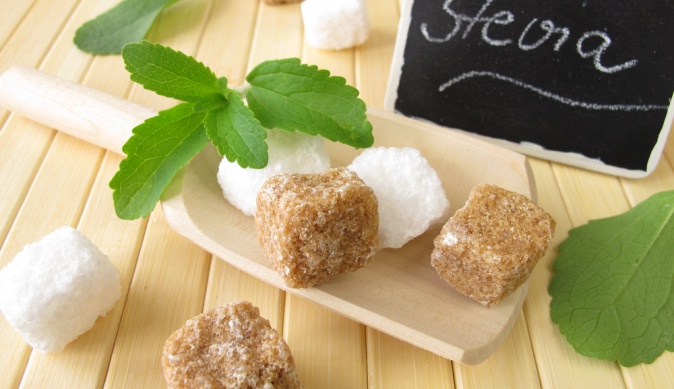 In 1952 it was established the chemical structure of the sweet components of stevia, stevioside. It has been established that it is dipertenovym glycoside consisting of three molecules of glucose and aglucone steviol (Wood et al., 1955 .; Wood and Fletcher, 1956).
In 1952 it was established the chemical structure of the sweet components of stevia, stevioside. It has been established that it is dipertenovym glycoside consisting of three molecules of glucose and aglucone steviol (Wood et al., 1955 .; Wood and Fletcher, 1956).
Furthermore stevioside in the leaves of stevia found other sweet glycosides - rebaudiosides (A, B, C, D and E), and steviolbioside duliobiozid with varying degrees of sweetness (50 to 450) to sucrose. Most of them sweet is rebaudioside A (degree of sweetness 350-450). In dry stevia leaves contains about 3% rebaudioside. Unlike stevioside it more soluble in water and its unpleasant aftertaste is less intense than the stevioside.
All of these isolated diterpenoidnyh glycosides chemical skeleton of the same - steviol, but they differ in carbohydrate residues at positions C13 and C19 (Shibata et al., 1995). Stevia sweeteners differ both in terms of sweetness and quantitative content in leaves. The main components of the leaves (in percentage of the dry weight) are: stevioside (5-10%), rebodiozid A (2-4%), rebodiozid C (1-2%) and dyulkozid A (0.4-0.7%) (Wood et al., 1955). The chemical structure of stevioside and related compounds, including steviol, rebodiozid A isosteviol and digidroizosteviol shown in the figure.
The sweetness of Stevia glycosides compared to sucrose as follows: for dyulkozida
And in 50-120 times for rebodiozida A - in 250-450 times, for rebodiozida B - 300-350 times for rebodiozida C - in 50-120 times for rebodiozida D - 250-450 in time for the E rebodiozida - 150-300 times for steviobiozida - in 100-125 times, for stevioside - 300 times (Crammer, Ikan, 1986).
On chemical structure of stevia sweeteners are tetracyclic diterpene glycosides, which is the aglycone steviol with no taste. Enzymatic hydrolysis of stevioside leads to the formation of 3 moles of D-glucose and 1 mole of steviol aglycone tasteless. When acid hydrolysis of stevioside formed D-glucose and aglycone isosteviol. Steviol structure similar to that of steroid hormone and possesses weak antiandrogenic activity (P. Mazzei et al., 1968). Stevioside is a white hygroscopic crystalline powder having a melting temperature of 196-198 0 C, readily soluble in water, stable to heat, so can be used for the preparation of dietetic foods and canned. It is 300 times sweeter than 0.4% sucrose, 150 - 4% solution and 100 times the sweetness of 10% sucrose solution (M. Bridel, R. Lavielle, 1931; B. Crammer, P. Jkan, 1986; E. Mosetting et al, 1963;. Jr Wood et al, 1955).. Sweet Aftertaste stevioside decreases in the presence of sucrose, glucose and fructose.
Biosynthesis diterpene glycosides in the leaves of stevia in the early stages of a common path with the biosynthesis of gibberellic acid - an important plant hormone that accelerates the growth of stems, interrupting the peace in the seeds and inducing flowering. The value diterpene glycosides of Stevia has not yet been established. Some scientists believe that these substances are distilled off insects, while others suggest that they control the level of gibberellic acid. It is found that the upper younger leaves have a lower sweetness than the older lower.
Besides sweets, stevioside some inherent bitterness and aftertaste it leaves the definition (Jakinovich et al., 1990). However, this problem can be solved by enzymatic modification using stevioside pullanazy (pullanase), isomaltase (Lobov et al., 1991),? -galactosidase (Kutahata et al., 1989) or dekstrinsaharazy (Yamamoto et al., 1994).
Sweeteners stkvii vypuskyut corrupt both as stevioside and stevia extract in the form of (Kinghorn, Soejarto, 2002; Brandle, Rosa, 1998). They are used in many types of food and goods, such as salt (pickled) vegetables, dry seafood, soy sauce, beverage, candy, chewing gum, ice cream and yogurt, as well as in the toothpaste and mouthwashes.
The most widely used as a sweetener stevioside received, since its content in the plant is higher. Technology selection of stevioside from leaves is quite complicated. It includes a liquid extraction with solvents such as chloroform-methanol, glycerol and propylene glycol, and then purification comprising extraction in a polar organic solvent, bleaching, coagulation, ion exchange chromatography and crystallization (Kinghorn & Soejarto, 1985; Pasquel et al, 2000.). Purification stevioside can be accomplished also by means of ion exchange chromatography alone, which is considered the best method. Then the aqueous extract was filtered again and precipitated stevioside purified by 90%. The technology of stevioside from Stevia leaves by extraction with hot water under high pressure (Pol et al., 2007), Predpriminimalis attempts to synthesize the compound, obtained some analogs having a sweet taste, but the detailed messages in this thread not. Great interest was shown Stevioside in Japan, where the first plants were introduced in 1970, and by 1978 the sale of products extracted from the leaves, already engaged in 12 companies. Since 1984, all the leading companies of Japan for the production of soft drinks began to be used as a full stevioside sweetener. In Japan it produced more sweeteners, which include the stevia "steviozin" - substantially pure stevioside and "steviks" - mixture of sweet glycosides from the stevia leaves. Steviks has a pleasant taste because of rebaudioside A, but it is less sweet because it contains other less sweet stevia glycosides. Furthermore, the mixture stevioside and glycyrrhizin (licorice extract) is used as a sweetener in Japan titled "A Maruleron". According to Japanese experts, stevioside is promising as a sweetener and in economic terms - it is three times cheaper than sugar (M. Yabu et al., 1977).
